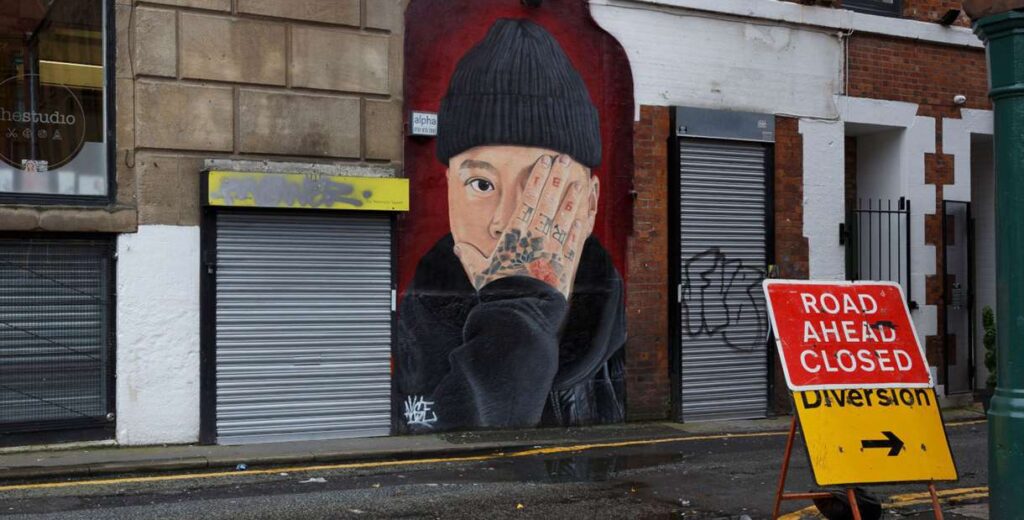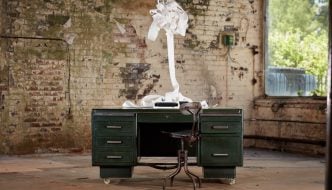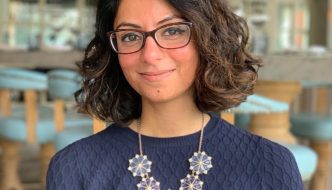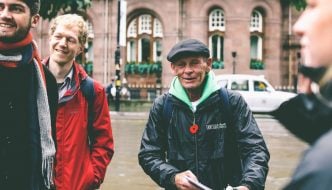
Work by AKSE, source
We’re well into the second week of new tiered restrictions in England after a notably more abysmal second lockdown. But, as I type from my bedroom desk overlooking a drizzly Manchester city centre, it doesn’t feel like much has changed since November 5th. Being placed back into tier 3 alongside much more of the North and Midlands, whilst expected, was personally depressing and culturally devastating to say the least.
Bitterness can’t help but be felt as the Tate Modern reopens and the West End welcomes back reduced audiences in London, while northern cultural venues are forced to remain closed, despite stringent efforts to make them COVID-secure. At least, more COVID-secure than retail stores currently allowed to swallow hordes of Christmas shoppers; desperate to find reasons to leave the house where art formerly provided them.
Thankfully, tier 3 hasn’t wiped culture off the map of North England entirely. The government’s £1.57 billion Culture Recovery Fund has ensured grandiose and grassroots organisations alike have kept the books balanced up to now. The Testbed in Leeds will provide a new pandemic-proof events space primed for social distancing, and, in Manchester, the recent ‘50 Windows of Creativity’ art trail implored Mancunians to head outdoors during the bleakest of months to bask in the beauty of 50 art installations from behind glass windows.
One such window housed the art of CJ Taylord, the creative mind behind the ‘Queen Bee’ of Sackville Gardens. His refreshingly positive outlook means, as an artist, he’ll “always be optimistic about the future,” which looks bright despite the pandemic as the personal touch he adds to symbols of Mancunian culture resonates more than ever with a socially-distanced audience.

CJ Taylord This is Me’
He added: “Going into this pandemic, I had the option to take control, thinking of new ways to reach people.” Having more time to enjoy painting, as well as keep up charitable work, is also realising his simple ambition to “make people happy,” having experienced “mental health challenges” and knowing the importance of positivity.
CJ’s current successes may seem to contrast the general misfortune of northern artists and audiences, but he definitely recognises “not everyone has been lucky, which is frustrating for people who put COVID-secure measures in place.” Those in Westminster who disregard northern arts and audiences would do well not to underestimate just how eager artists are to get back to their rightful places and to maintain the arts as a long-fought-for viable career path.
One such artist is a fellow ‘50 Windows’ featured painter, Amy Coney, who has seen her mural painting taking a back seat as bars and offices who normally commission her have closed. For Amy, “a lot happened too late” in terms of government support, but she “would say the same for the handling of the intrinsically linked hospitality industry.

Amy Coney ‘We Will Dance Together Again’
“The pandemic has highlighted much more than the bias [against the arts],” referring to social inequalities throughout the UK and the world, which can’t help but be identified in the differential treatment of north and south England. Even valid justifications for it, like hospital capacities being lower in the north, are representative of a centuries-old disregard for communities outside the Westminster bubble.
How do we combat this, though, as artists and audiences up north? Amy went on to suppose “all we can do is adapt to keep our business and be seen. We didn’t spend all this time fighting to make something we love viable as a career to have it taken away by COVID. After all, art will always be what unifies us.”
Unity was also on the mind of another ’50 Windows’ featured artist, Danielle Rhoda, who mused: “we’re all surrounded by creativity, from your Yorkshire Tea box, to postage stamps, to tear-jerking Christmas adverts,” proof that “art in all forms can be and is definitely a real job.”
Danielle’s work as an illustrator attests to this, persevering through lockdown-induced, unintentional unemployment and ensuing mental health drawbacks to achieve her dream of working for herself. Having carved herself a new groove as a freelance artist, Danielle still finds herself “struggling with identity” in her art because of a longing for the atmosphere of physical, creative spaces, which “have always been considered second class in the fabric of British society.”

Danielle Rhoda ‘A Day in Manchester’
Danielle’s observations are no more plainly displayed in how the high street has been prioritised by Westminster over hospitality and art. For the north, adding the double burden of being singled out as deserving of stricter restrictions, for whatever reason, has been all the more destructive to creative industries here, for both finances and morale.
While the pandemic continues to rage and restrictions on the arts continue their unwelcome stay, there appears to be a consensus among artists to persist with homegrown art consumed in digital, domestic and outdoor spaces while the galleries and exhibition spaces they also belong in remain out of bounds.
The relationship between the government and the stakeholders of northern art may be damaged, and the economic support may be too little too late, but rest assured that on the horizon is a renaissance of northern culture which will see artists take the trials and tribulations, tears and triumphs brought on by coronavirus restrictions and transform them into beautiful artwork to empower generations of northerners who, as Danielle Rhoda so sweetly put it, “all deserve a little bit of joy.”
Filed under: Art & Photography
Tagged with: Amy Coney, art, artist, bee in the city, bias, CJ Taylord, covid-19, Danielle Rhoda, government, manchester, northern, pandemic, tier, trail, westminster, windows



Comments